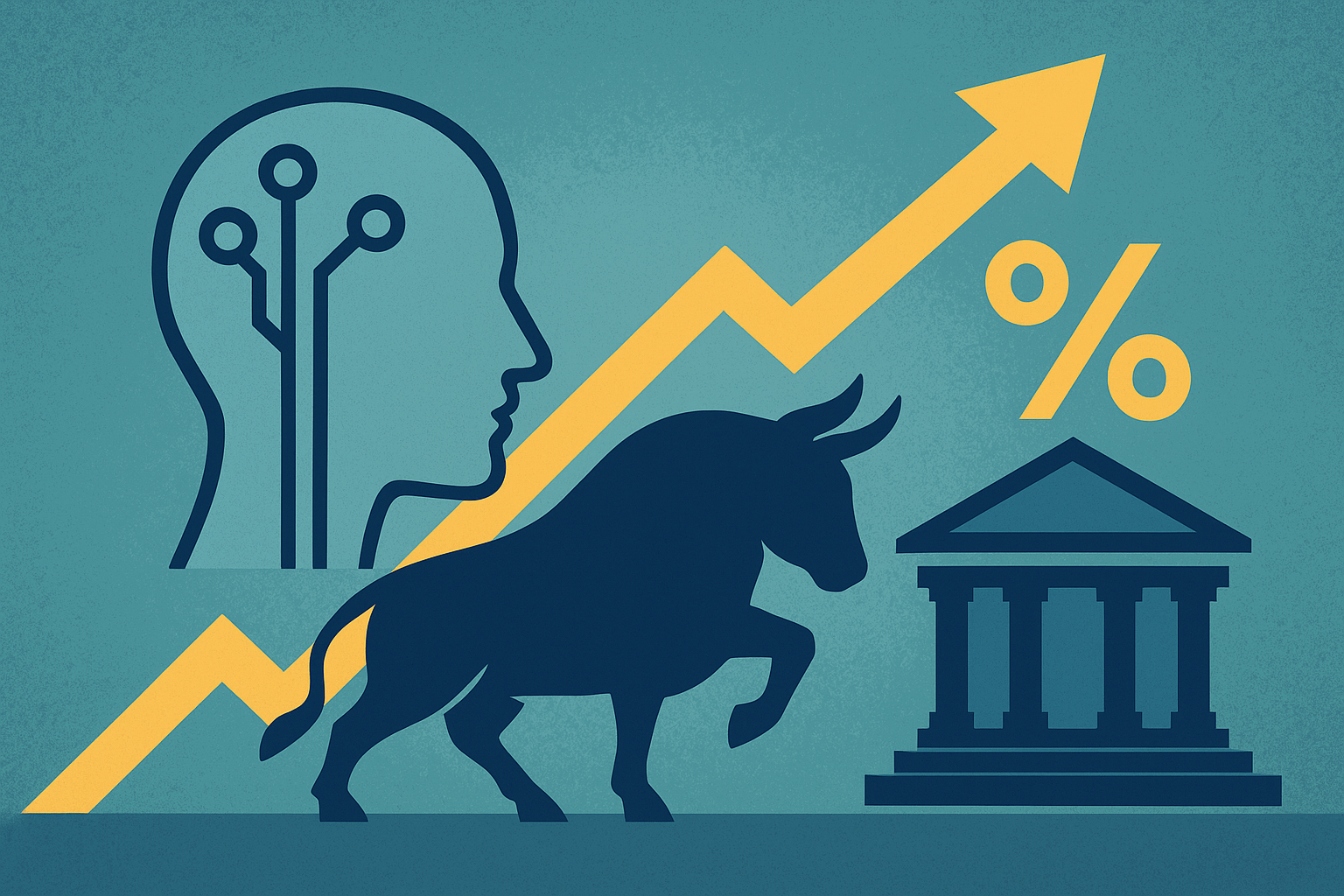The opening week of October has started on an upbeat note for Wall Street, as futures climbed higher Monday morning amid renewed optimism surrounding artificial intelligence (AI) investments and expectations that the Federal Reserve could deliver its long-awaited rate cut this quarter. Despite the ongoing U.S. government shutdown, investor sentiment remains firmly risk-on — driven by deal activity across the AI sector and a broad belief that the next leg of the market rally will be powered by both technological innovation and monetary easing.
According to Reuters, futures for the S&P 500, Nasdaq 100, and Dow Jones Industrial Average rose between 0.4% and 0.6% in early trading. The gains were led by AI-exposed mega-cap stocks and semiconductor manufacturers, whose strong balance sheets and innovation pipelines continue to attract inflows amid global uncertainty.
AI-Fueled Optimism Outweighs Shutdown Fears
While political gridlock in Washington has halted the release of official economic data, investors are increasingly relying on corporate updates and sector-specific indicators to gauge momentum. The narrative dominating markets is clear: AI remains the key growth catalyst for U.S. equities, and investors are positioning accordingly.
Recent developments — including OpenAI’s multibillion-dollar chip procurement deal with AMD, Microsoft’s continued expansion in AI cloud infrastructure, and rising corporate capital expenditure on AI computing power — have reinforced confidence that the sector’s investment cycle is far from over.
“The next six months will likely see AI capital intensity double,” said a Goldman Sachs equity strategist in a Monday note. “Even with macro uncertainty, the productivity story is too strong to ignore — and markets are starting to price that in.”
Why This Matters for Investors
The current rally highlights a crucial market dynamic: AI and interest rate policy are moving in tandem to shape risk sentiment. Traders now assign more than a 70% probability of a Fed rate cut by December, according to CME FedWatch data, as inflationary pressures continue to moderate.
If realized, lower borrowing costs could unlock further investment in capital-heavy AI infrastructure — from chip fabs to data centers and edge computing networks. Companies such as Nvidia ($NVDA), AMD ($AMD), Microsoft ($MSFT), and Alphabet ($GOOGL) are seen as key beneficiaries in this dual tailwind environment.
However, the sustainability of this rally is not guaranteed. Analysts at Morgan Stanley cautioned that “AI trade concentration remains elevated, and any delay in rate cuts could trigger profit-taking in the near term.” The divergence between high-flying tech names and lagging cyclical sectors could widen, creating short-term volatility.
Global Context: AI as a Market Driver
Beyond the U.S., global markets are mirroring the same pattern. European chipmakers ASML and Infineon Technologies saw gains on expectations that AI-driven demand would boost semiconductor sales through 2026. Meanwhile, Asian markets remain upbeat after TSMC signaled a robust recovery in advanced chip orders linked to generative AI applications.
The International Data Corporation (IDC) recently projected that global spending on AI systems will exceed $400 billion by 2026, up from $184 billion in 2024 — a trajectory that underpins the sector’s growth appeal to institutional investors.
AI’s expanding footprint across industries — from finance and healthcare to defense and manufacturing — continues to attract not just speculative interest, but also strategic capital allocation. Hedge funds and sovereign wealth funds alike are increasing exposure to AI infrastructure plays, data analytics providers, and chip manufacturing.
Future Trends to Watch
- AI-Driven M&A Acceleration: Expect continued consolidation as major players secure supply chain control, particularly in semiconductors and cloud computing.
- Interest Rate Impact: A delayed or smaller-than-expected Fed rate cut could pressure overvalued growth names, leading to sector rotation toward energy, defense, or industrials.
- Data Infrastructure Expansion: As demand for training large AI models grows, the global race for power, cooling, and network infrastructure will become a defining investment theme for 2026.
- Geopolitical and Policy Risk: The U.S. shutdown and European political instability (e.g., France’s government collapse) may drive short-term volatility, testing market resilience.
Key Investment Insight
For investors, AI remains both an opportunity and a concentration risk. The sector’s fundamentals — driven by capital spending, innovation, and global adoption — are powerful, but valuation discipline is critical. Diversifying within the AI theme — into semiconductors, infrastructure, and applied software — may provide more balanced exposure than chasing mega-cap leaders alone.
Short-term traders can ride the momentum on clear rate-cut signals, while long-term investors should look for quality AI firms with strong cash flow and real-world adoption, not just hype.
As the line between macroeconomics and technology continues to blur, AI is evolving into the market’s new policy barometer — influencing everything from rates to risk appetite.
Stay Ahead
For continuous coverage on AI-driven markets, monetary policy shifts, and emerging investment trends, follow MoneyNews.Today — your trusted source for actionable, data-backed investor insights.





